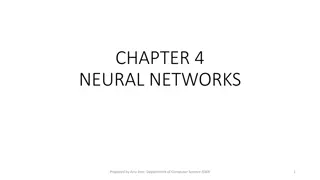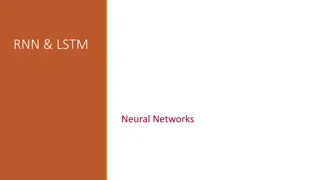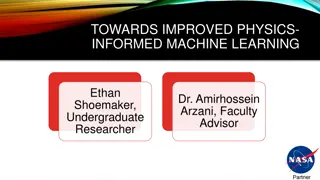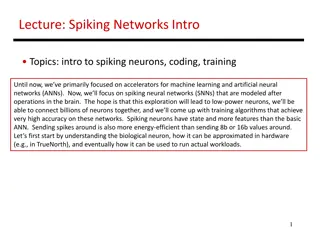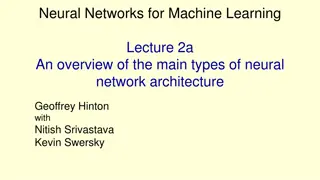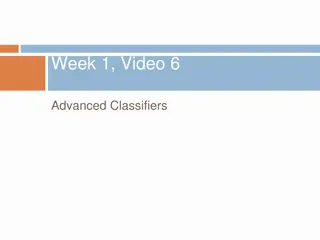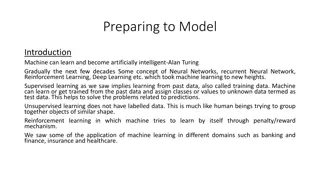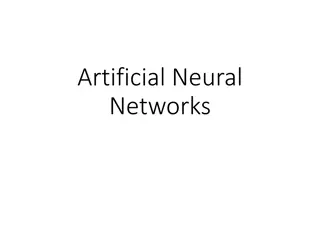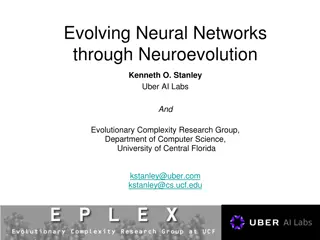Introduction to Neural Networks in Machine Learning
Explore the fundamentals of neural networks in machine learning, covering topics such as activation functions, architecture, training techniques, and practical applications. Discover how neural networks can approximate continuous functions with hidden units and understand the biological inspiration behind their design.
Download Presentation

Please find below an Image/Link to download the presentation.
The content on the website is provided AS IS for your information and personal use only. It may not be sold, licensed, or shared on other websites without obtaining consent from the author.If you encounter any issues during the download, it is possible that the publisher has removed the file from their server.
You are allowed to download the files provided on this website for personal or commercial use, subject to the condition that they are used lawfully. All files are the property of their respective owners.
The content on the website is provided AS IS for your information and personal use only. It may not be sold, licensed, or shared on other websites without obtaining consent from the author.
E N D
Presentation Transcript
CS 2750: Machine Learning Neural Networks Prof. Adriana Kovashka University of Pittsburgh February 28, 2017
Announcements HW2 due Thursday Office hours on Thursday: 4:15pm-5:45pm Talk at 3pm: http://www.sam.pitt.edu/arc- 2017/arc2017-schedule/ Exam Mean 53.04 (76%) Median 56.50 (81%)
Plan for the next few lectures Neural network basics Architecture Biological inspiration Loss functions Training with gradient descent and backpropagation Practical matters Overfitting prevention Transfer learning Software packages Convolutional neural networks (CNNs) Special operations for processing images Recurrent neural networks (RNNs) Special operations for processing sequences (e.g. language)
Neural network definition Activations: Nonlinear activation function h (e.g. sigmoid, tanh, RELU): Figure from Christopher Bishop
Neural network definition Layer 2 Layer 3 (final) Outputs (multiclass) (binary) Finally: (binary)
Activation functions Leaky ReLU max(0.1x, x) Sigmoid tanh(x) tanh Maxout max(0,x) ReLU ELU Andrej Karpathy
A multi-layer neural network Nonlinear classifier Can approximate any continuous function to arbitrary accuracy given sufficiently many hidden units Lana Lazebnik
Inspiration: Neuron cells Neurons accept information from multiple inputs transmit information to other neurons Multiply inputs by weights along edges Apply some function to the set of inputs at each node If output of function over threshold, neuron fires Text: HKUST, figures: Andrej Karpathy
Multilayer networks Cascade neurons together Output from one layer is the input to the next Each layer has its own sets of weights HKUST
Feed-forward networks Predictions are fed forward through the network to classify HKUST
Feed-forward networks Predictions are fed forward through the network to classify HKUST
Feed-forward networks Predictions are fed forward through the network to classify HKUST
Feed-forward networks Predictions are fed forward through the network to classify HKUST
Feed-forward networks Predictions are fed forward through the network to classify HKUST
Feed-forward networks Predictions are fed forward through the network to classify HKUST
Deep neural networks Lots of hidden layers Depth = power (usually) Weights to learn! Weights to learn! Weights to learn! Weights to learn! Figure from http://neuralnetworksanddeeplearning.com/chap5.html
How do we train them? There is no analytical solution for the weights We will iteratively find such a set of weights that allow the outputs to match the desired outputs We want to minimize a loss function (a function of the weights in the network) For now let s simplify and assume there s a single layer of weights in the network
Softmax loss scores = unnormalized log probabilities of the classes where Want to maximize the log likelihood, or (for a loss function) to minimize the negative log likelihood of the correct class: cat 3.2 5.1 -1.7 car frog Andrej Karpathy
Softmax loss unnormalized probabilities 3.2 5.1 -1.7 cat 0.13 0.87 0.00 24.5 164.0 0.18 L_i = -log(0.13) = 0.89 normalize exp car frog unnormalized log probabilities probabilities Adapted from Andrej Karpathy
Regularization L1, L2 regularization (weight decay) Dropout Randomly turn off some neurons Allows individual neurons to independently be responsible for performance Dropout: A simple way to prevent neural networks from overfitting [Srivastava JMLR 2014] Adapted from Jia-bin Huang
Gradient descent We ll update the weights Move in direction opposite to gradient: L Time Learning rate Figure from Andrej Karpathy
Mini-batch gradient descent Rather than compute the gradient from the loss for all training examples, could only use some of the data for each gradient update We cycle through all the training examples multiple times; each time we ve cycled through all of them once is called an epoch Allows faster training (e.g. on GPUs), parallelization Figure from Andrej Karpathy
Gradient descent in multi-layer nets How to update the weights at all layers? Answer: backpropagation of error from higher layers to lower layers Figure from Andrej Karpathy
How to compute gradient? In a neural network: Gradient is: Denote the errors as: Also:
Backpropagation: Error For output units (e.g. identity output, least squares loss): For hidden units: Backprop formula:
Example (identity output function) Two layer network w/ tanh at hidden layer: Derivative: Minimize: Forward propagation:
Example (identity output function) Errors at output: Errors at hidden units: Derivatives wrt weights:
Backpropagation: Graphic example First calculate error of output units and use this to change the top layer of weights. output k Update weights into j j hidden input i Adapted from Ray Mooney, equations from Chris Bishop
Backpropagation: Graphic example Next calculate error for hidden units based on errors on the output units it feeds into. output k j hidden input i Adapted from Ray Mooney, equations from Chris Bishop
Backpropagation: Graphic example Finally update bottom layer of weights based on errors calculated for hidden units. output k Update weights into i j hidden input i Adapted from Ray Mooney, equations from Chris Bishop
Comments on training algorithm Not guaranteed to converge to zero training error, may converge to local optima or oscillate indefinitely. However, in practice, does converge to low error for many large networks on real data. Thousands of epochs (epoch = network sees all training data once) may be required, hours or days to train. To avoid local-minima problems, run several trials starting with different random weights (random restarts), and take results of trial with lowest training set error. May be hard to set learning rate and to select number of hidden units and layers. Neural networks had fallen out of fashion in 90s, early 2000s; back with a new name and significantly improved performance (deep networks trained with dropout and lots of data). Ray Mooney, Carlos Guestrin, Dhruv Batra
Over-training prevention Running too many epochs can result in over-fitting. error on test data on training data 0 # training epochs Keep a hold-out validation set and test accuracy on it after every epoch. Stop training when additional epochs actually increase validation error. Adapted from Ray Mooney
Determining best number of hidden units Too few hidden units prevents the network from adequately fitting the data. Too many hidden units can result in over-fitting. error on test data on training data 0 # hidden units Use internal cross-validation to empirically determine an optimal number of hidden units. Ray Mooney
Effect of number of neurons more neurons = more capacity Andrej Karpathy
Effect of regularization Do not use size of neural network as a regularizer. Use stronger regularization instead: (you can play with this demo over at ConvNetJS: http://cs.stanford. edu/people/karpathy/convnetjs/demo/classify2d.html) Andrej Karpathy
Hidden unit interpretation Trained hidden units can be seen as newly constructed features that make the target concept linearly separable in the transformed space. On many real domains, hidden units can be interpreted as representing meaningful features such as vowel detectors or edge detectors, etc. However, the hidden layer can also become a distributed representation of the input in which each individual unit is not easily interpretable as a meaningful feature. Ray Mooney
You need a lot of data if you want to train/use deep nets Transfer Learning Adapted from Andrej Karpathy
Transfer learning: Motivation The more weights you need to learn, the more data you need That s why with a deeper network, you need more data for training than for a shallower network But: If you have sparse data, you can just train the last few layers of a deep net Set these to the already learned weights from another network Learn these on your own task
Transfer learning Source: e.g. classification of animals Target: e.g. classification of cars 3. Medium dataset: finetuning 1. Trainon source (large dataset) 2. Small dataset: more data = retrain more of the network (or all of it) Freeze these Freeze these Trainthis Trainthis Lecture 11 - 29 Another option: use network as feature extractor, train SVM/LR on extracted features for target task Adapted from Andrej Karpathy
Pre-training on ImageNet Have a source domain and target domain Train a network to classify ImageNet classes Coarse classes and ones with fine distinctions (dog breeds) Remove last layers and train layers to replace them, that predict target classes Oquab et al., Learning and Transferring Mid-Level Image Representations , CVPR 2014
Transfer learning with CNNs is pervasive Image Captioning Karpathy and Fei-Fei, Deep Visual- Semantic Alignments for Generating Image Descriptions , CVPR 2015 CNN pretrained on ImageNet Object Detection Ren et al., Faster R-CNN , NIPS 2015 Adapted from Andrej Karpathy
Another soln for sparse data: Augmentation Create virtual training samples Horizontal flip Random crop Color casting Geometric distortion Deep Image [Wu et al. 2015] Jia-bin Huang
Packages Caffe and Caffe Model Zoo Torch Theano with Keras/Lasagne MatConvNet TensorFlow
Learning Resources http://deeplearning.net/ http://cs231n.stanford.edu (CNNs, vision) http://cs224d.stanford.edu/ (RNNs, language)
Summary Feed-forward network architecture Training deep neural nets We need an objective function that measures and guides us towards good performance We need a way to minimize the loss function: (stochastic, mini-batch) gradient descent We need backpropagation to propagate error towards all layers and change weights at those layers Practices for preventing overfitting, training with little data





